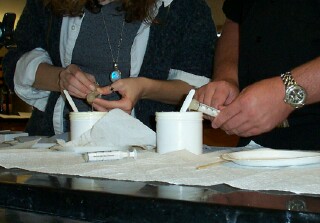|
Report
#8: building prototypes, continued, and summary of student
reports on Dr. Pocius's lecture
Report
prepared by MMA engineers:
- 2/C
Maguire
- 3/C
McQueen
- 2/C
Pike
- 3/C
Sunde
- UCCRTS
technician: Bodio
On
October 23rd, the cadets and technicians were asked to design
a prototype applicator that Alvin could use. My cadet and
I used two zip locked baggies. In the corners of bag number
one and bag number two, we placed one-to-one ratio of both
parts A and B epoxy 326, making sure not to mix them up. Then
we placed a paper plate on the lab table where we mixed both
A + B epoxy together with a wooden popsicle stick. After we
produced a mixture, we applied it on a black rubber stopper
and placed the two bags corners of epoxy A and epoxy B on
top. (Editor's query: Is the bottom of the stopper coated
with mixed epoxy and the top of the stopper has the two baggies?
Or is the mixed epoxy used to hold the baggies in place?)
Answer:
I believe this was Cadet Holcroft's project but, as I remember,
the bottom of the stopper was covered in mixed epoxy so as
to attach the baggies to it.

Syringes
used to dispense equal amounts of part A and part B of PSI-326
epoxy
We
designed a either a land (?) or hand adhesive marker applicator.
After we (built it), we let it set up in chilled (sea) water.
The temperature of the chilled water was 2 degrees Celcius
and the sea water temperature outside was 15 degrees Celcius.
We placed a rock in the ice water. We left it under the water
for a significant amount of time before we took out the rock
with both epoxies in the chilled water. (Editor's query: Is
this a rock with a rubber stopper epoxied to it and also two
baggies with part A and part B separated to see if the viscosity
of part A and part B has changed when chilled? Cadet engineer:
Please send Dr. Sichel a sketch to add to your technician's
report.)
In
conclusion, we found out our (adhesive) did not work (in chilled
seawater). We felt the problem was due to the temperaure of
the seawater because, according to my cadet, it worked last
week (at ambient temperature). The other cold water tests
performed today include:
-
PSI 326 part A+B will not saturate a sponge in cold water.
-
Pre-loaded A+ B epoxy (components) in air mixed okay in
cold water. details: The project that Cadet Pike and Cadet
Maguire designed involved a square of heavy aluminum and
two sponges. The sponges where affixed to the aluminum using
the smart glue. The sponges where then coated with the A
and B parts. The apparatus is then pressed onto the rock
and rotated to mix the epoxy. In the ambient water test
the glue was placed on the sponges and immediately pressed
onto the rock. This test was successful. The A and B parts
mixed and cured, securing the apparatus to the rock. In
the cold water test sea water was chilled to 2 C. The A
and B parts where applied and the apparatus was immersed
and allowed to chill for 15 min. After it was chilled the
apparatus was pressed and rotated onto the rock. This test
was a success as the glue was still able to function after
being chilled for 15 min.
-
Cadet 3/C Sunde's 1st adhesive test on the rock worked.
(Editor's note: The epoxy was mixed underwater, by placing
a spoonful of part A and a spoonful of part B separately
on the submerged rock surface, and then mixing them.) When
the test was repeated, on a fresh spoonful of part A and
part B, the next test didn't work. (Possible) reasons (for
the test failure) are: unknown fresh batch epoxy for each.
(Editor's comment: I am not sure what you mean here.)
-
Test of silicone caulking adhesive-- 2nd test adhesive to
rock. (Editor's query: Did the silicone caulk work under
water? Did it set up and harden?)
-
2-syringe applicator didn't work in the cold water. Pre-loading
the tube(syringe?) applicator...at room temperature... can't
pre-mix...because the epoxy would begin to set-up... works
well in cold water.
Last Thursday's guest speaker, in my opinion,
was very beneficial. I wish that he had come earlier in the
project. If he had, I think that it would have given more
direction to the problem at hand and given us a better understanding
of what was happening.
The information that I gained both proved and
disproved some of my thoughts on the outcome of our experiments.
I am also eager to get back into the lab and use this new
knowledge.
This week a 3M representative came in to speak
to us about the chemistry involved in making adhesives. I
found the speaker to be very informative. I realized just
how complicated the process really is in making different
types of adhesives. It was a good supplement to what we are
learning about in class. I also learned that using a silicone
based adhesive might be better suited for underwater use.
This past Thursday, Dr. Pocius spoke on basic
adhesive theory and science. I explained to him the problem
my group was having mixing and applying the adhesive completely
underwater. As you know, the epoxy (PSI-326, "Smart Glue")
will set and cure underwater. However, as the class period
goes on, it becomes harder to apply. Dr. Pocius explained
that most likely, excluding human error, it is setting up
faster due to the cold water, and other conditions. I wish
to experiment with this further and find out how much the
problem is due to human error, and how much it is due to the
conditions.
|

